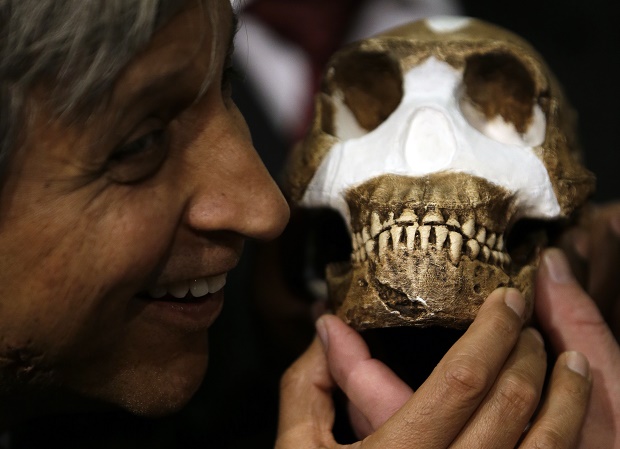‘Hobbits’ not humans like us — study

Professor Adam Habib, holds a reconstruction of Homo naledi presented during the announcement made in Magaliesburg, South Africa, on Sept. 10, 2015. Scientists say they’ve discovered a new member of the human family tree, while in France, scientists said the ‘hobbits’ found in Indonesia were ‘not human like us.’ AP FILE
PARIS, France — Diminutive humans that died out on an Indonesian island some 15,000 years ago were not Homo sapiens but a different species, according to a study published Monday that dives into a fierce anthropological debate.
Fossils of Homo floresiensis — dubbed “the hobbits” due to their tiny stature — were discovered on the island of Flores in 2003.
READ: Study: Bones in South African cave reveal new human relative | Oldest engraving rewrites view of human history
Controversy has raged ever since as to whether they are an unknown branch of early humans or specimens of modern man deformed by disease.
The new study, based on an analysis of the skull bones, shows once and for all that the pint-sized people were not Homo sapiens, according to the researchers.
Until now, academic studies have pointing in one direction or another — and scientific discourse has sometimes tipped over into acrimony.
One school of thought holds that so-called Flores Man descended from the larger Homo erectus and became smaller over hundreds of generations.
The proposed process for this is called “insular dwarfing” — animals, after migrating across land bridges during periods of low sea level, wind up marooned on islands as oceans rise and their size progressively diminishes if the supply of food declines.
An adult hobbit stood a meter (three feet) tall, and weighed about 25 kilos (55 pounds).
Similarly, Flores Island was also home to a miniature race of extinct, elephant-like creatures called Stegodon.
But other researchers argue that H. floresiensis was in fact a modern human whose tiny size and small brain — no bigger than a grapefruit — was caused by a genetic disorder.
One suspect was dwarf cretinism, sometimes brought on by a lack of iodine. Another potential culprit was microcephaly, which shrivels not just the brain and its boney envelope.
Weighing in with a new approach, published in the Journal of Human Evolution, a pair of scientists in France used high-tech tools to re-examine the layers of the “hobbit” skull.
More precisely, they looked at the remains of Liang Bua 1 (nicknamed LB1), whose cranium is the most intact of nine known specimens.
Mystery solved?
“So far, we have been basing our conclusions on images where you don’t really see very much,” said lead author Antoine Balzeau, a scientist at France’s Natural History Museum.
Joining forces with Philippe Charlier, a palaeopathologist at Paris-Descartes University specialized in solving ancient medical mysteries, the researchers secured high-resolution images recently generated in Japan to compute maps of bone thickness variation.
“There is a lot of information contained in bone layers of the skull,” Balzeau told AFP.
The results, he said, were unambiguous: “There were no characteristics from our species” — that is, Homo sapiens.
And while they found evidence of minor maladies, there was nothing corresponding to the major genetic diseases other researchers had pointed to.
But if one part of the mystery may be solved, another remains intact.
For while the scientists could not exclude the possibility that the “hobbit” was a scaled-down version of Homo erectus, which arrived on the neighboring island of Java some million years ago, nor could they be sure that H. floresiensis was not a species it its own right.
“For the moment, we can’t say one way or the other,” Balzeau said.